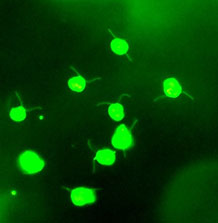Eukaryotic swimming

Many eukaryotes swim by the active whip-like motion of eukaryotic flagella or cilia (terms that are used somewhat interchangeably). These organelles are found in almost the same form throughout the eukaryotes, from single-celled malaria and leishmania parasites up to plants, fungi and animals. They line parts of the human airway where they clear debris and pump fluid, and are central to human reproduction: sperm tails and the cilia lining the oviduct. We use model systems like the algal species Chlamydomonas reinhardtii to try to understand how these structures move in three dimensions, with a combination of applied mathematical analysis and holographic imaging (see references below). The photo next to this text shows a dark field image of C. reinhardtii showing the 8 µm diameter cell bodies from which the hair-like flagella project.
Key publications
N.E Farthing, R.C. Findlay, J.F. Jikeli, P.B. Walrad, M.A. Bees and L.G. Wilson. Opt. Express 25(23) p.28489 (2017).
J.F. Jikeli, L. Alvarez, B.M. Friedrich, L.G. Wilson et al., Nat. Commun. 6 7985 (2015).
L.G. Wilson, L.M. Carter & S.E. Reece. Proc. Natl. Acad. Sci. USA 110(47) p.18769 (2013).
V.A. Martinez, R. Besseling, O.A. Croze, J. Tailleur, M. Reufer, J. Schwarz-Linek, L.G. Wilson, M.A. Bees & W.C.K. Poon. Biophys. J. 103 p. 1637 (2012).
